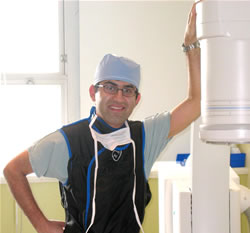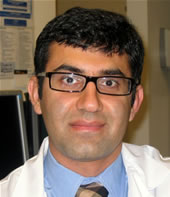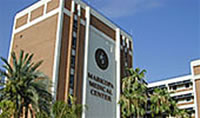 |

|
 |

Having learned
the transradial access technique as a fellow in Canada, Dr.
Mehrdad Saririan brought this experience with him to the
Lahey Clinic in Boston, where he completed his interventional
fellowship and, as he relates, "my passion
for radial catheterization and the perceived novelty of the
technique
earned me the
nickname of radial man." Dr.
Saririan lectured and taught transradial intervention
to the physicians at
Lahey and initiated their radial program, which is now the
largest in Massachusetts.
Dr. Saririan moved to Phoenix
and is now the Director of the Cardiac Catheterization
Lab at Maricopa Medical Center, the largest teaching hospital
in the Phoenix metro area. A self-confessed radial evangelist,
Saririan taught the technique to his division chief,
Dr. Jay Kaufman, and
together they currently perform over 80% of their cases from
the wrist. They
will also be teaching a one-day course in the radial
technique at Maricopa,
on December 5, 2008 (see
more information the course and registering).
For more about the transradial approach, visit our Radial
Access Center. |
|

Mehrdad Saririan,
MD
Maricopa Medical Center
Phoenix, Arizona |

Dr. Mehrdad
Saririan |
|
Q: When did you first start
using the radial approach?
Dr. Saririan: Radial procedures
were commonplace when I was a trainee and cardiology fellow.
Where I started my cath lab rotation, people were doing radial
procedures routinely, so it wasn’t something novel; it was
routine. I trained with radial puncture as being first line
access, so for me it was the norm. I learned the technique
at McGill University in Montreal, Canada and my mentor, Dr.
Jean-Pierre Beaudry, was kind enough to let me do the radial
punctures. It wasn't anything special. It wasn't a novel idea.
It was how we did things. And that's how I learned the radial
technique. Afterwards I went on to the Montreal Heart Institute
where I did my first year of interventional fellowship and
that's when we did more and more and that’s where I learned
my radial interventional skills, as opposed to just angiography
skills. Montreal Heart Institute is where the first radial
procedure was described by Dr. Campeau back in '89, so it was
a fitting place to learn the technique.
|
Q: Radial access is more popular in Canada and other countries
than in the U.S? Why?
Dr. Saririan: Radial catheterization is not the norm in Canada
either, but there is a higher majority of interventionalists that
practice the approach there than here in the United States. I think
that the number one driving force for adopting the radial procedure
in Canada is cost. Because Canada has socialized healthcare,
cost is always an issue. There's less cost associated with a radial
hemostasis device than with a femoral vascular closure device.
Also from the arm it's very easy to engage both coronaries with
a single multipurpose diagnostic catheter, so that’s another
way that costs are decreased, by using a single multipurpose catheter.
And there's less cost in terms of hospitalization and complications.
So I think part of the reason why radial procedures are common
in Canada is because of the necessity to contain costs associated
with this procedure.
Also, once that has been established and
referring physicians have caught onto the idea, they are now
requesting it more and
more commonly. A friend of mine who's at the Jewish General Hospital
in Montreal told me, “If you're not doing radial procedures,
you're not going to get referrals.” So referring cardiologists
are now expecting that their patients be done radially, because
the patients are so much happier when the procedure is done that
way.
Q: Have you experienced this advantage,
where
patients
prefer
to come
to a radial center?
Dr. Saririan: I initially started my career in Phoenix in private practice and
it was a huge competitive advantage for me. I had a lot of referrals from competing
interventional cardiologists because of patients who were obese and the referring
cardiologist could not do the procedure femorally. For a few patients I had them
referred to me directly for a radial procedure. Oftentimes I would scrub in with
the interventional cardiologist and teach them how to do the procedure themselves.
But in the past year-and-a-half, I have left private practice and I have joined
the county hospital here in Phoenix and this is a closed system and we don’t
make much noise. But we use radial as our first line access, and do 80% of our
cases from the wrist. I stopped counting after I had done 1,000 cases this way.
Q: Cardiologists who are "femoralists"
still look suspiciously at the radial technique and claim that
you can run into problems with
trauma, needing a larger artery to do certain procedures, etc.
Dr. Saririan: These are criticisms that are very common. The common
objection that I have heard to the radial procedure is the learning
curve: if you don't learn radial during your interventional training,
then once you're out in private practice, it becomes difficult
to
pick up. So that's the first common objection. Another is that
you're going to traumatize the radial
artery.
There
is a
small incidence of radial artery occlusion. My answer to the trauma
aspect is: (a) surgeons use the radial artery for grafts, so obviously
the hand can do without the radial artery, if the Allen's test
is normal, and (b) even if you traumatize the radial artery, and
the radial artery occludes, if the patient has a normal Allen's
test, all studies have shown so far that the incidence of radial
artery occlusion is completely clinically silent. So, I think that
argument is overblown.
A third objection is that you can't do
procedures which require higher French sizes. Again the common
answer to that
objection
is that 95% of the techniques we use in the cath lab require only
a 6F sheath. It's rare that we need to upsize to 8F sheaths nowadays.
Stent technology, wire technology, everything has been miniaturized.
We can do kissing balloons through 6F sheaths; we can do rotational
atherectomies through 6F sheaths; we can do AngioJet through 6F
sheaths. So I think that's a non-argument. That may have been true
in the old days when everyone would use 8F sheaths for routine
interventions, but that's not the case anymore. We know that higher
sheath sizes are associated with higher bleeding complications.
So I would not know why one would want to upsize to an 8F sheath
anyway. You're just going increase your bleeding complications.
The vast majority of things can be done through a 6F sheath.
The final common objection that I've
heard is the availability of femoral vascular closure devices.
They say, “Well,
I can use an AngioSeal and my patients are up in two hours and
I don't have any bleeding
complications.” But if you look
at the actual meta-analyses of all the femoral closure devices
that have been studied and compare that to manual compression,
the only
thing
that closure devices have been proven to do well, is to decrease
the time to ambulation. There's not one study that has definitively
proven that closure devices actually decrease bleeding complications
and bleeding rates, compared to manual compression. So with that
in mind, I think the radial approach far surpasses the femoral
approach in terms of all these complications and all these objections.
Q: Dr, Sunil Rao observed in his
recent study that the NCDR data seem to show
a spike in the use of radial in the U.S. in the last quarter
of 2007, although the usage is still in very low single
digits.
Dr. Saririan: I think the reasons for it have been driven by recent
studies associating bleeding and mortality. The radial proponents
have been trying for more adoption of this procedure ever since
it was developed in the 90's, except our voices had always been
quieted down because of lack of industry support, because of lack
of support in the national guidelines. Finally we're having people,
such as Dr. Jeff Popma and Dr. Gregg Stone, coming out and saying, “Hey
listen -- bleeding is bad and, if there's a way that we can decrease
it beyond pharmacologic means, we should adopt it.” I
think industry finally is getting on board. I think soon it will
make national guidelines. I think third-party payers will finally
catch up to this and say. “Hey this benefits my patients.
I will reimburse you more if you do a radial technique than if
you do a femoral technique.”
There are a lot more training programs now, so I'm hopeful that
in the next few years the radial access technique will at least
surpass 10% in the NCDR data.
Q: Speaking of training,
you have a course coming up on December 5, 2008.
Dr. Saririan:
There are a lot of myths surrounding radial procedures. And
I think a course like ours that can try to debunk some of
these myths is very important. So if you can have a sit-down
with a person who does large volume of radial PCIs and you
go over some of the tips and tricks of the technique and
you try to debunk some of these myths associated with radial
catheterization, that’s very important. Simulation training
is also very helpful. It's obviously not as good as having
practice on live patients, but it is the second-best thing,
so I think simulation training is very useful and we are
incorporating that into our course.
|
|

Maricopa
Medical Center
Phoenix, Arizona |
Finally live case demonstrations. In our first
course, our physician trainees won't actually be scrubbing in, but
they at least will be able to be in the cath lab, watching as things
are being done and they'll be able to ask questions as they are occurring.
So I think those three components are very important: a sit down
didactic teaching session going though some of the tips
and tricks,
simulation and finally live observation. In the future we are hoping
to include a practical component, where you would come here and
actually do a procedure, but there are some hurdles with respect
in terms of malpractice insurance, etc., but I'm hoping we can
overcome those.
Q: You've mentioned reimbursement. Is this something that's going
to become more important in the next year or two, because of the
changes that are going to be happening in the field of healthcare?
Dr. Saririan: I think we're going to see pay-for-performance and
pay-for-quality measures -- that goes without saying. Anything
that you can do to decrease hospitalization costs and decrease
complications should be encouraged and should be reimbursed accordingly.
So that's why I think that the radial technique should become more
and more routine and established here in the U.S., especially with
these proven changes in how medical procedures will be reimbursed.
It's only common sense.
Q: We've discussed some of these,
but what are the specific areas where radial can reduce the
costs of an angioplasty?
Dr. Saririan: First thing is bleeding complication rates. No patient
has ever died from a retroperitoneal bleed from a radial puncture.
That's something that can clearly prolong hospitalization stay.
There's less cost associated with transfusions. There's less
cost associated with imaging techniques in order to diagnose
the bleeding whether it be ultrasound or CT. There are fewer
costs associated with femoral closure devices. And I think soon
we will see a change in reimbursement rates such that we will outpatient
PCIs. Patients will not stay in hospital overnight. They will
be able to go home early. And the hospital and physician will
still be reimbursed the same way. At least I hope that's what's
going to happen. So, in all those ways, less hospital stay, no
overnight hospital stay and no bleeding complications, no CT,
no ultrasound, no vascular closure devices -- in all those ways,
I think you can reduce your costs associated with this procedure.
Q: What about complications from the radial? Some patients have
written into our Forum that when they leave the hospital their
arm is sore and they feel a discomfort in their arm. Does this
go away?
Dr. Saririan: In respect to the discomfort in the arm, I also think
a lot of femoral patients complain of discomfort in their
groin. The fact that you puncture an artery and you have a vascular
hemostasis device that's applied over the artery, for a small period
of time, I should think that one should expect to have a sore wrist
at least initially, maybe for the first day or so. But it's not
been my experience where patients have had chronic arm pain because
of the radial puncture.
Other potential complications are radial thrombosis or radial
occlusion -- but all of the studies that have been done so far
have shown that this is usually clinically silent. Bleeding complications
are virtually non-existent. The most I have seen is a mid-forearm
hematoma due to aggressive wiring techniques, which is part of
the tips and tricks that a physician needs to learn when they are
learning radial procedures. That's rare and usually can easily
be taken care of by an ACE bandage. Bruising is common but it's
not considered a major bleeding complication.
Q: What currently is the role of
the device manufacturers in terms of the advances in equipment
for the radial approach?
Dr. Saririan: The role of the equipment manufacturers has been key in establishing
the radial technique. Had it not been for the better wires, the more deliverable
balloons, the more deliverable stents, I do not think that we would have been
able to do routine radial procedures as we do now. It's only because we can do
90+% of the current interventional techniques through a 6F guide that we are
able to do radial procedures today. The fact that stents are more deliverable
and the fact that the thrombectomy devices and distal protection devices can
be done through 6F sheaths are all reasons why radial procedures have been adopted
at least the world over, if not in the United States.
Q: What is the role of the professional societies?
Dr. Saririan: If the societies and the well-known experts in the
field of interventional cardiology don't come out and promote
this idea it won't be adopted as a matter of routine. So the
societies will play a major role in pushing interventional cardiologists
and training programs to adopt the radial technique.
But until and unless it makes it into the
guidelines as a Class 1 or at least a Class 2A, I don't see
it as becoming more common than
a few niche practitioners here and there. So the TCT, the ACC and
the i2 summit, the SCAI will play huge roles in promoting this
technique. I think it's coming. Clearly, as you said, the NCDR
data shows a spike in the last quarter of 2007 – and that's
because a lot of these publications that are coming out with respect
to bleeding mortality and people are waking up to the fact that
bleeding is bad and, if there's a way to reduce this from a radial
puncture, then it should be adopted as a matter for patients’ safety
sake. So those societies will play a huge role and I think it's
going to make it to the guidelines if not in the next revision,
then the one after.
Q: Dr. Saririan, thank you
for your time. I’m
sure your thoughts and experiences will be helpful to the readers
who visit
Angioplasty.Org 100,000 times a month.
Dr. Saririan: You’re welcome. I think your site is the only
one that's promoting the radial technique in the U.S., so I commend
you and your website for creating such an avenue for physicians
to
educate
themselves. There's no other site that's doing this as well as
you guys are doing it. I think people who want to learn the radial
technique will need to log on to your website.
| Registration for Dr. Saririan's Transradial
Access Training Program in Phoenix is currently open, but there
are only a few spaces
left. More information can be found here. |
This interview was conducted
in November 2008 by Burt Cohen of Angioplasty.Org.
|




